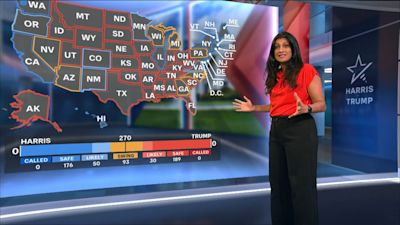US election 2024: Why a tiny handful of voters could decide who becomes president

ITV News Deputy Political Editor Anushka Asthana takes us through how the electoral college system works in the US election
To best understand what the US presidential election really comes down to, compare the electoral map in 2016 to its 2020 equivalent.
When you delve into how Joe Biden turned the US from Republican red to Democrat blue, you quickly understand just how tight the margins are.
In 2020, five out of America's 50 states changed hands. If Trump had won back just three of them, he would have been president. How could he have done that?
By winning over just 43,000 votes across Wisconsin, Georgia and Arizona - which amount to less than 0.03% of the 150 million votes cast.
The reason that a tiny handful of voters can decide who is president of the United States is the electoral college, established in the 18th century as a compromise between those who wanted the country's president to be elected by a popular vote and those who wanted Congress to decide.
Many believe it is long past its use-by-date, but for now, it continues as the system for electing arguably the most powerful politician in the world.
Each state is given a set number of electoral college votes based on the number of politicians it has. Given that every state has two senators, whatever its size, and one Congressman or woman, the minimum number of votes for a state is three.
Critics argue that this helps Republicans because rural states with small populations (that tend to be red) punch above their weight in electoral college votes. Wyoming's three votes spread across a population of just under 600,000 translates to 1 per 200,000 voters.
While California's 54, across its 39m residents, works out as 1 per 700,000 people. (There is one exception - the very blue Washington DC is given 3 votes because it does not have representation in Congress).
Most US states have tended to vote reliably in one direction or another, which means that the entire election is likely to come down to the movements in a relatively small number of swing states - with seven seen as particularly key.
They are Wisconsin, Pennsylvania and Michigan, in a former industrial heartland known as the "Rust Belt", and then four states spread across the so-called "Sun Belt" - Arizona and Nevada to the West, and Georgia and North Carolina to the east.
I say likely because it isn't certain that everywhere else will go as expected. In fact, in recent days a shock poll suggested that Iowa could swing Democrat. And there are other states - like Florida and Texas (both with a huge number of electoral votes) that were only very narrowly red last time around.
Through the night, my colleagues and I will be delving into the results as they land, and we have some really excellent data to help us tell the story. We will wait for our partner CNN to actually call states, but before that are two data sets from our friends at the AP news agency.
AP VoteCount will be able to tell us what proportion of the vote has been counted across a state and who is ahead at that time. It comes with a giant dose of caution because sometimes states swing one way and then another (eg in some cases, Democrats tend to surge first for the simple reason that the ballot boxes in urban areas are quicker to transport to the counting centres).
But we also have AP VoteCast. This is a huge survey that has been running over the past week and right up to election day. Last time round it involved 110,000 voters, with a very strong sample in individual states - of around 4,000 in our key areas. It will not tell us who has won, but it will delve into the underlying trends that could decide this election.
Listen to female voters in America and it is clear that abortion has been a huge motivating issue for many of them. So the question tonight will be - has Kamala Harris pushed up the female vote?
Subscribe free to our weekly newsletter for exclusive and original coverage from ITV News. Direct to your inbox every Friday morning.
Could the Democrats take a lead among white women - a group they have trailed among for the past few elections? If so, those types of movements could be absolutely key in Pennsylvania - for eexample - our most valuable swing state with 19 electoral college votes.
Or is the narrative of Donald Trump winning over the "bro vote" going to show up in tonight's figures? In 2020 - Joe Biden had a massive lead with black voters in Georgia (the swing state with the largest black population) - he won 92% of that vote, Trump just 6%.
If the phenomenon being reported on is true - if black men swing to Trump even slightly - could that gap be squeezed, hugely helping the Republican candidate?
This is the type of data we will get minutes after polls close, with the first tranche at midnight UK time, including the key state of Georgia, followed by North Carolina at 12.30 and then Pennsylvania at 1.
We will also keep across all the US broadcasters so you know what is being said across the US.
Want an expert briefing on US politics and the presidential race? Listen to our latest podcast Talking Politics USA